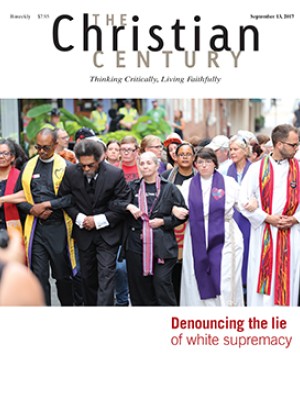October 1, Ordinary 26A (Matthew 21:23-32)
Love has come into the world and is walking even now.
This past Lent, our church did a worship series focusing on communion. We tried to see with new eyes what sharing in the communion of Christ could look like in our time and place. In the wake of the election last November, edginess, tension, and fear had crept into our wider community and our life together as church. So it felt particularly right and important to remember who we are as the beloved community and what sharing in communion looks like.
The Fifth Sunday in Lent was also the first Sunday in April. For us, that meant it was a communion Sunday. As worship began, I remember feeling grateful for that wooden communion table at the front of the sanctuary, a table full of fresh bread and cups of juice, a table of welcome and abundance.
Read our latest issue or browse back issues.
I was about halfway through the sermon, sharing how I had come to see not the cross but the communion table as the defining symbol of our faith, when the side door to the sanctuary opened and Harriet (I will call her) walked in. Harriet had been worshiping with us off and on ever since first coming to the church a couple of months back as one of the guest artists from Common Art. The Boston-based program provides space, materials, and caring staff to support unhoused and low-income people as they develop their artistic abilities. As Harriet entered the sanctuary, the door shut loudly behind her. Several people glanced in her direction.
I continued preaching. “Communion was not just the purpose of Jesus’ life,” I said, “but is to be also the purpose of church. We are to be instruments of that love, working towards healing and wholeness for others and for the world.”
As I spoke, Harriet made her way past the pulpit. She crossed the front of the sanctuary and was about to head down the center aisle to take a pew. Then the table caught her eye. Switching up her trajectory, she drew close to the table and began helping herself to the bread. She ate one piece, then another and another. I was still preaching, but the attention in the sanctuary had clearly shifted to Harriet. I felt everyone watching her and wondering what to do. After a couple of more minutes at the table, Harriet filled both of her hands with bread, made her way about halfway down the center aisle, and slipped into a pew.
I felt the congregation relax. I was almost finished with the sermon. But then—Harriet was up, again. She was making her way back to the table for more bread. At this point, one of our deacons—I’ll call her Brenda—slipped out of her pew and walked unhurriedly up to the table as well. Standing next to Harriet, Brenda wrapped her arm lovingly around Harriet’s shoulders. When Harriet was finished—when she had all the bread she needed—they turned together and walked slowly back to the pew, Harriet holding the bread in her hands and Brenda holding Harriet. Then they slid into the pew, side by side, together.
In this week’s passage from Matthew’s Gospel, the chief priests and elders ask Jesus by what authority he is doing the things he is doing. He has been making them uncomfortable, disrupting the usual way of things. They are concerned about whether his actions are permissible. Are they to be allowed? I may have been the one preaching that Sunday in April, but I could hear the unspoken words of many in the room, words that, truth be told, were on my mind as well as Harriet disrupted our worship and tarried over the communion table. What is she doing? That is not allowed. She should not be doing that. Someone should be stopping her.
But when I saw Brenda put her arm around Harriet there at the table, as Harriet satisfied her hunger with the abundance of the bread, the word came home to me in a way that suddenly made it crystal clear what was happening. While I had been going on and on about the purpose of the church and our call to communion, God had something else in mind for our time together—something God wanted to show us. What God wanted to show us was what communion could look like in our place and our time. There it was: an arm around the shoulders, a filled belly, all the time in the world, and a place in the pew for them both, side by side. There it was, so perfectly simple and powerfully real.
On this World Communion Sunday, there is still so much that divides us one from another. There is still much edginess, tension, and fear. The question the chief priests and elders ask may still be on our lips and on the lips of many others as we question the legitimacy of policies and priorities and wonder how best to make our way in this world. This is fine and good and what we need to be doing.
But in the midst of it all, I hope we also can see what is also right in front of us, what Jesus says is apparent to tax collectors and prostitutes though hidden from those who think they are in the know. And that is that love has come into the world and is walking even now, in the way of communion. It turns out that evidence is all around us. I hope to have the eyes to see it and a heart to enter in. But even if I don’t, I trust that God will continue to make it abundantly clear.





